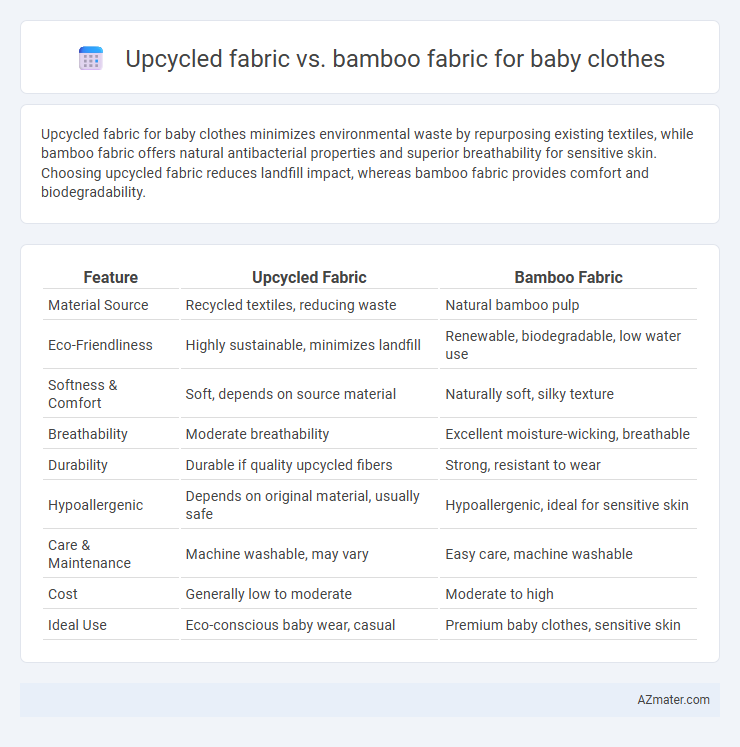Upcycled fabric for baby clothes minimizes environmental waste by repurposing existing textiles, while bamboo fabric offers natural antibacterial properties and superior breathability for sensitive skin. Choosing upcycled fabric reduces landfill impact, whereas bamboo fabric provides comfort and biodegradability.
Table of Comparison
| Feature | Upcycled Fabric | Bamboo Fabric |
|---|---|---|
| Material Source | Recycled textiles, reducing waste | Natural bamboo pulp |
| Eco-Friendliness | Highly sustainable, minimizes landfill | Renewable, biodegradable, low water use |
| Softness & Comfort | Soft, depends on source material | Naturally soft, silky texture |
| Breathability | Moderate breathability | Excellent moisture-wicking, breathable |
| Durability | Durable if quality upcycled fibers | Strong, resistant to wear |
| Hypoallergenic | Depends on original material, usually safe | Hypoallergenic, ideal for sensitive skin |
| Care & Maintenance | Machine washable, may vary | Easy care, machine washable |
| Cost | Generally low to moderate | Moderate to high |
| Ideal Use | Eco-conscious baby wear, casual | Premium baby clothes, sensitive skin |
Introduction to Sustainable Baby Fabrics
Upcycled fabric for baby clothes utilizes reclaimed materials, reducing waste and lowering environmental impact by giving new life to discarded textiles. Bamboo fabric offers a naturally antibacterial, hypoallergenic, and biodegradable option, harvested from fast-growing bamboo plants that require minimal water and no pesticides. Both sustainable choices promote eco-friendly practices, with upcycled fabric emphasizing waste reduction and bamboo fabric highlighting renewable resource use.
What Is Upcycled Fabric?
Upcycled fabric refers to textile materials repurposed from pre-existing products or waste, reducing environmental impact by minimizing textile waste in baby clothing production. In comparison to bamboo fabric, which is derived from bamboo pulp and known for its softness and breathability, upcycled fabric promotes sustainability by extending the lifecycle of materials already in circulation. Selecting upcycled fabric for baby clothes supports eco-friendly practices while offering unique textures and reducing dependency on new resource consumption.
What Is Bamboo Fabric?
Bamboo fabric is a natural textile made from the pulp of bamboo grass, known for its softness, breathability, and antibacterial properties, making it ideal for baby clothing. It offers moisture-wicking benefits and is hypoallergenic, which helps reduce skin irritation and allergies in sensitive baby skin. Compared to upcycled fabric, bamboo fabric provides a sustainable yet luxurious option with a strong focus on comfort and health safety for infants.
Environmental Impact: Upcycled vs Bamboo Fabric
Upcycled fabric for baby clothes significantly reduces waste by repurposing existing textiles, minimizing landfill contributions and lowering resource consumption. Bamboo fabric, while biodegradable and naturally antimicrobial, demands intensive water and chemical use during processing, impacting its overall eco-friendliness. Choosing upcycled materials promotes circular economy principles, offering a more sustainable environmental impact compared to bamboo fabric production.
Softness and Comfort for Babies
Upcycled fabric offers a gentle, sustainable option with a smooth texture that minimizes irritation, ideal for sensitive baby skin. Bamboo fabric boasts natural softness due to its fine fibers, providing excellent breathability and moisture-wicking properties that enhance baby comfort. Both materials prioritize eco-friendliness while delivering exceptional softness and comfort tailored to delicate infant needs.
Safety and Chemical Concerns
Upcycled fabric for baby clothes typically reduces chemical exposure by repurposing existing textiles without introducing new dyes or treatments, making it an eco-friendly and safer option. Bamboo fabric is naturally antimicrobial and hypoallergenic but often undergoes chemical-intensive processing to convert bamboo pulp into soft fibers, raising concerns about residual solvents. Choosing baby clothes made from certified organic bamboo or untreated upcycled fabric helps minimize exposure to harmful chemicals and ensures safer skin contact for infants.
Durability and Longevity
Upcycled fabric for baby clothes often offers high durability due to the reuse of sturdy textiles, making it a sustainable choice that withstands frequent washing and wear. Bamboo fabric, while naturally soft and breathable, tends to have moderate durability but excels in moisture-wicking and hypoallergenic properties beneficial for sensitive baby skin. Choosing between the two depends on prioritizing long-lasting fabric density in upcycled materials versus the eco-friendly softness and comfort of bamboo.
Ease of Care and Maintenance
Upcycled fabric for baby clothes often requires gentle washing to preserve its reclaimed fibers, but it resists common wear and stains due to its sturdy nature. Bamboo fabric offers excellent ease of care with natural antibacterial properties, allowing frequent machine washing without degrading softness or durability. Both materials provide eco-friendly options, but bamboo fabric's inherent moisture-wicking and quick-drying features simplify maintenance for active babies.
Cost Comparison: Upcycled vs Bamboo Baby Clothes
Upcycled fabric baby clothes generally offer a lower cost option compared to bamboo fabric, due to the reuse of existing textiles which reduces raw material expenses. Bamboo fabric baby clothes tend to be pricier, reflecting the processing involved in converting bamboo fibers into soft, breathable material, as well as their eco-friendly appeal. Parents often find upcycled baby clothes more budget-friendly, while bamboo garments provide added benefits such as natural antimicrobial properties and enhanced comfort.
Choosing the Best Fabric for Your Baby
Upcycled fabric offers sustainability by repurposing pre-existing textile waste, making it an eco-friendly choice for baby clothes that reduces environmental impact. Bamboo fabric stands out for its natural softness, hypoallergenic properties, and excellent breathability, ensuring gentle comfort and safety for sensitive baby skin. Prioritize factors like durability, moisture-wicking ability, and chemical-free processing when choosing the best fabric for your baby's comfort and health.

Infographic: Upcycled fabric vs Bamboo fabric for Baby cloth
 azmater.com
azmater.com